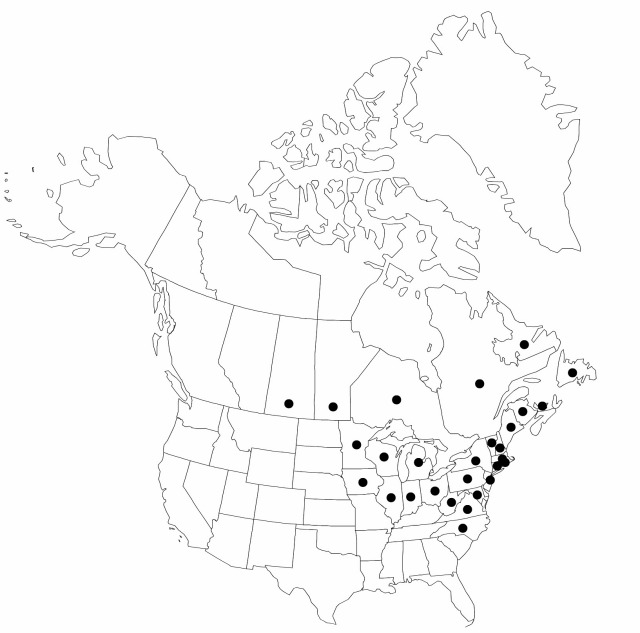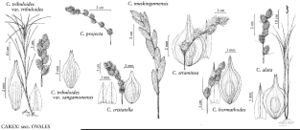Difference between revisions of "Carex projecta"
Bull. Torrey Bot. Club 35: 264. 1908.
FNA>Volume Importer |
FNA>Volume Importer |
||
| Line 24: | Line 24: | ||
|elevation=10–400 m | |elevation=10–400 m | ||
|distribution=Man.;N.B.;Nfld. and Labr.;Ont.;P.E.I.;Que.;Sask.;Conn.;Ill.;Ind.;Iowa;Maine;Md.;Mass.;Mich.;Minn.;N.H.;N.J.;N.Y.;N.C.;Ohio;Pa.;R.I.;Vt.;Va.;W.Va.;Wis. | |distribution=Man.;N.B.;Nfld. and Labr.;Ont.;P.E.I.;Que.;Sask.;Conn.;Ill.;Ind.;Iowa;Maine;Md.;Mass.;Mich.;Minn.;N.H.;N.J.;N.Y.;N.C.;Ohio;Pa.;R.I.;Vt.;Va.;W.Va.;Wis. | ||
| − | |discussion=<p>In many respects Carex projecta is intermediate between C. cristatella and C. tribuloides; it is sometimes difficult to distinguish from those species. However, when all three species occur together, C. projecta flowers and fruits first, C. tribuloides later, and C. cristatella latest of all. When C. projecta is in mature fruit, C. cristatella will be just past flowering.</p><!-- | + | |discussion=<p>In many respects <i>Carex projecta</i> is intermediate between <i>C. cristatella</i> and <i>C. tribuloides</i>; it is sometimes difficult to distinguish from those species. However, when all three species occur together, <i>C. projecta</i> flowers and fruits first, <i>C. tribuloides</i> later, and <i>C. cristatella</i> latest of all. When <i>C. projecta</i> is in mature fruit, <i>C. cristatella</i> will be just past flowering.</p><!-- |
| − | --><p>See note under 146. Carex longii.</p> | + | --><p>See note under 146. <i>Carex longii</i>.</p> |
|tables= | |tables= | ||
|references= | |references= | ||
| Line 49: | Line 49: | ||
|publication year=1908 | |publication year=1908 | ||
|special status= | |special status= | ||
| − | |source xml=https://jpend@bitbucket.org/aafc-mbb/fna-data-curation.git/src/ | + | |source xml=https://jpend@bitbucket.org/aafc-mbb/fna-data-curation.git/src/8f726806613d60c220dc4493de13607dd3150896/coarse_grained_fna_xml/V23/V23_639.xml |
|genus=Carex | |genus=Carex | ||
|section=Carex sect. Ovales | |section=Carex sect. Ovales | ||
Revision as of 17:09, 18 September 2019
Plants densely cespitose. Culms 50–90 cm; vegetative culms with numerous leaves spaced evenly along distal 1/2. Leaves: sheaths adaxially green-veined nearly to collar with V-shaped hyaline band extending 4–20 mm proximal to collar, somewhat loose, expanded near summit, ± wing-angled, adaxially firm, summits thin, U-shaped to rounded, sometimes shortly prolonged beyond collar; distal ligules 4–9 mm; blades 3–6 per fertile culm, 18–40 cm × 3–7 mm. Inflorescences nodding, open at least proximally, pale brown, 2.5–6 cm × 7–14 mm; proximal internode 5–12(–18) mm; 2d internode 3–11 mm; proximal bracts scalelike, sometimes bristlelike to 3 cm. Spikes 8–15, proximal spikes well spearated, nearly globose, 9–12 × 6–8(–9) mm, base tapered, apex rounded. Pistillate scales white to brown with brown or green midstripe not reaching tip, oblong-lanceolate to oblong-ovate, 2–2.7 × 0.9–1.5 mm, shorter and narrower than perigynia, apex obtuse to nearly acute. Perigynia usually 15–30 per spike, ascending to reflexed, with divergent beak, pale brown; conspicuously (3–)5–8-veined abaxially, conspicuously 3–6-veined adaxially, lanceolate, flat to plano-convex, thin, 2.9–4.3 × 1.2–1.6 mm, 0.3 mm thick, margin flat, including wing 0.2 mm wide; beak sometimes red-brown at tip, flat, ciliate-serrulate, distance from beak tip to achene 1.6–2.4 mm. Achenes ovate to oblong, 1.1–1.7 × 0.6–1 mm, 0.3 mm thick. 2n = 64.
Phenology: Fruiting early–mid summer.
Habitat: Stream banks, moist depressions in mixed and deciduous forests, moist to wet grasslands, meadows, thickets, shores, ditches
Elevation: 10–400 m
Distribution

Man., N.B., Nfld. and Labr., Ont., P.E.I., Que., Sask., Conn., Ill., Ind., Iowa, Maine, Md., Mass., Mich., Minn., N.H., N.J., N.Y., N.C., Ohio, Pa., R.I., Vt., Va., W.Va., Wis.
Discussion
In many respects Carex projecta is intermediate between C. cristatella and C. tribuloides; it is sometimes difficult to distinguish from those species. However, when all three species occur together, C. projecta flowers and fruits first, C. tribuloides later, and C. cristatella latest of all. When C. projecta is in mature fruit, C. cristatella will be just past flowering.
See note under 146. Carex longii.
Selected References
None.
